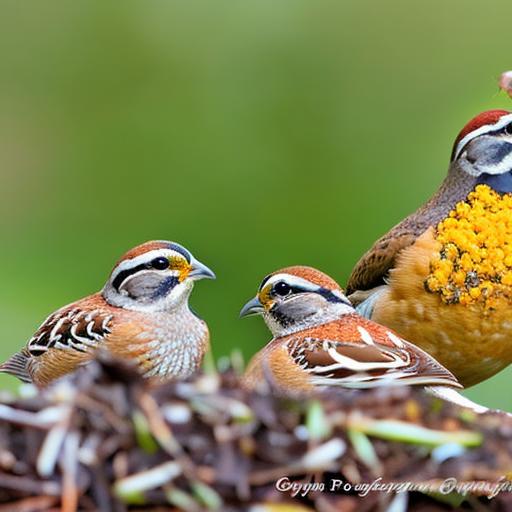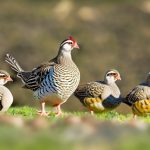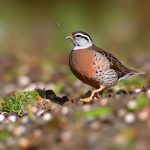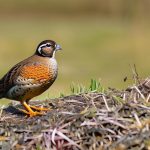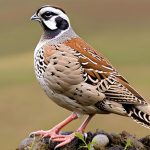Quails are small, ground-dwelling birds that are known for their distinctive calls and quick, darting movements. They are social birds that often gather in groups called coveys, and they are primarily active during the day. Quails are also known for their nesting habits, as they prefer to build their nests on the ground in areas with dense vegetation for protection. Understanding quail behavior is essential for creating a habitat that is conducive to their needs. By observing their natural behaviors, you can better understand their preferences for food, shelter, and nesting sites. This knowledge will help you create a quail-friendly environment that encourages these birds to thrive on your property.
Quails are omnivorous birds that feed on a variety of seeds, insects, and vegetation. They prefer to forage in areas with low-growing plants and open ground, where they can easily access their food sources. Additionally, quails require dense cover for protection from predators and nesting sites. By understanding these behaviors, you can design a habitat that provides the necessary food sources and shelter for quails to thrive. This may involve planting native grasses and shrubs, creating brush piles, and leaving areas of open ground for foraging. By understanding quail behavior, you can create a habitat that meets their specific needs and encourages them to establish a presence on your property.
Key Takeaways
- Quail are ground-dwelling birds that prefer open areas with low vegetation and access to water.
- Creating a quail-friendly habitat involves providing suitable cover, food sources, and water, as well as minimizing disturbances.
- Implementing deterrents such as scare devices and repellents can help keep quail away from unwanted areas.
- Using physical barriers like fences and netting can effectively prevent quail from accessing specific areas.
- Removing attractive nesting materials such as tall grass and brush can discourage quail from nesting in unwanted areas.
- Encouraging natural predators like snakes and raptors can help control quail populations in a natural and non-invasive way.
- Seeking professional help from wildlife experts or conservation organizations can provide valuable guidance and support in managing quail populations and habitats.
Creating a Quail-Friendly Habitat
Creating a quail-friendly habitat involves providing the necessary resources for these birds to thrive. This includes food sources, shelter, and suitable nesting sites. One of the most important aspects of creating a quail-friendly habitat is providing the right vegetation. Quails prefer areas with low-growing plants, such as native grasses and shrubs, which provide cover for foraging and nesting. Additionally, creating brush piles and leaving areas of open ground can provide additional shelter and foraging opportunities for quails. It’s also important to provide a reliable water source, as quails require access to fresh water for drinking and bathing.
In addition to providing the right vegetation and water sources, it’s important to manage your property in a way that minimizes disturbances to quail habitat. This may involve limiting the use of pesticides and herbicides, reducing mowing frequency in certain areas, and avoiding activities that disrupt nesting sites. By creating a habitat that meets the specific needs of quails and minimizing disturbances, you can encourage these birds to establish a presence on your property. Creating a quail-friendly habitat requires careful planning and management, but the rewards of seeing these beautiful birds thrive on your property are well worth the effort.
Implementing Deterrents
Implementing deterrents is an effective way to discourage quails from frequenting certain areas of your property. There are several methods you can use to deter quails, including visual deterrents, auditory deterrents, and scent deterrents. Visual deterrents, such as scarecrows or reflective tape, can be effective at deterring quails by making them feel threatened or uncomfortable in certain areas. Auditory deterrents, such as ultrasonic devices or predator calls, can also be used to discourage quails from entering specific areas. Scent deterrents, such as predator urine or strong-smelling plants, can be effective at deterring quails by making them feel unsafe in certain areas.
It’s important to note that while deterrents can be effective at discouraging quails from certain areas, they should be used in conjunction with other methods for long-term success. Additionally, it’s important to regularly change the location and type of deterrents to prevent quails from becoming accustomed to them. By implementing a variety of deterrents and regularly changing their placement, you can effectively discourage quails from frequenting certain areas of your property.
Using Physical Barriers
Using physical barriers is an effective way to prevent quails from accessing certain areas of your property. There are several types of physical barriers that can be used to deter quails, including fences, netting, and barriers made from natural materials. Fences can be used to create a physical barrier that prevents quails from entering specific areas, such as gardens or sensitive habitats. Netting can be used to cover plants or other areas where quails may cause damage, preventing them from accessing these areas. Barriers made from natural materials, such as thorny bushes or prickly plants, can also be effective at deterring quails by creating an uncomfortable or impassable barrier.
When using physical barriers to deter quails, it’s important to ensure that they are properly installed and maintained to be effective. This may involve regularly inspecting fences and netting for damage, and replacing or repairing them as needed. Additionally, it’s important to consider the potential impact of physical barriers on other wildlife species and the overall ecosystem of your property. By using physical barriers strategically and responsibly, you can effectively prevent quails from accessing certain areas of your property while minimizing negative impacts on other wildlife.
Removing Attractive Nesting Materials
Quails are ground-nesting birds that prefer to build their nests in areas with dense vegetation for protection. By removing attractive nesting materials from certain areas of your property, you can discourage quails from establishing nests in these locations. This may involve clearing away dense vegetation, such as tall grasses or shrubs, from areas where you do not want quails to nest. Additionally, removing debris or clutter from these areas can also discourage quails from nesting there.
It’s important to note that while removing attractive nesting materials can be effective at discouraging quails from nesting in certain areas, it should be done in conjunction with other methods for long-term success. Additionally, it’s important to regularly monitor these areas and remove any new nesting materials that may appear. By removing attractive nesting materials from certain areas of your property and regularly monitoring these locations, you can effectively discourage quails from establishing nests in these areas.
Encouraging Natural Predators

Encouraging natural predators is an effective way to control quail populations on your property. Predators such as hawks, owls, foxes, and snakes are natural predators of quails and can help keep their populations in check. By providing suitable habitat for these predators and avoiding activities that may harm them, you can encourage them to establish a presence on your property and help control quail populations naturally.
One way to encourage natural predators is by providing suitable habitat for them to thrive. This may involve leaving areas of dense vegetation for cover and nesting sites, providing access to water sources, and avoiding the use of pesticides or other chemicals that may harm predators. Additionally, it’s important to avoid activities that may harm predators, such as trapping or shooting them. By creating a habitat that supports natural predators and avoiding activities that may harm them, you can encourage these animals to help control quail populations on your property.
Seeking Professional Help
If you are struggling to manage quail populations on your property or are unsure of the best methods to use, seeking professional help is a wise decision. There are wildlife management professionals who specialize in managing bird populations and can provide valuable insight and assistance in managing quails on your property. These professionals can assess the specific needs of your property and develop a management plan that is tailored to your unique situation.
In addition to wildlife management professionals, there are also organizations and agencies that provide resources and assistance for managing bird populations. These organizations may offer educational materials, workshops, or other resources that can help you better understand how to manage quail populations on your property. By seeking professional help and utilizing available resources, you can gain valuable knowledge and support in managing quails on your property.
In conclusion, understanding quail behavior is essential for creating a habitat that meets their specific needs and encourages them to thrive on your property. By providing the necessary resources for these birds to thrive and minimizing disturbances to their habitat, you can create a quail-friendly environment that supports healthy populations of these beautiful birds. Implementing deterrents, using physical barriers, removing attractive nesting materials, encouraging natural predators, and seeking professional help are all effective methods for managing quail populations on your property. By using a combination of these methods strategically and responsibly, you can effectively manage quails on your property while supporting healthy ecosystems for all wildlife species.
If you’re looking for ways to keep quail from nesting in your garden, you may also be interested in learning about the importance of the right chicken coop door size. A well-designed coop door can help prevent unwanted visitors and provide security for your poultry. Check out this informative article on poultrywizard.com to discover how the right door size can make a difference in maintaining a safe and comfortable environment for your chickens.
FAQs
What are quail and why do they nest in gardens?
Quail are small ground-dwelling birds that are known for nesting in a variety of habitats, including gardens. They may be attracted to gardens for the availability of food, shelter, and nesting sites.
What are some methods to keep quail from nesting in my garden?
Some methods to keep quail from nesting in your garden include using physical barriers such as fences or netting, removing potential nesting sites such as tall grass or brush piles, and using scare tactics such as noise makers or visual deterrents.
Are there any plants that can deter quail from nesting in my garden?
Some plants, such as prickly or thorny bushes, can act as a deterrent for quail nesting in your garden. These plants create an inhospitable environment for nesting and can help discourage quail from settling in your garden.
Is it legal to remove quail nests from my garden?
It is important to check local regulations and laws regarding the removal of quail nests from your garden. In some areas, quail may be protected species and disturbing their nests may be illegal. It is best to consult with local wildlife authorities before taking any action.
Meet Walter, the feathered-friend fanatic of Florida! Nestled in the sunshine state, Walter struts through life with his feathered companions, clucking his way to happiness. With a coop that’s fancier than a five-star hotel, he’s the Don Juan of the chicken world. When he’s not teaching his hens to do the cha-cha, you’ll find him in a heated debate with his prized rooster, Sir Clucks-a-Lot. Walter’s poultry passion is no yolk; he’s the sunny-side-up guy you never knew you needed in your flock of friends!

